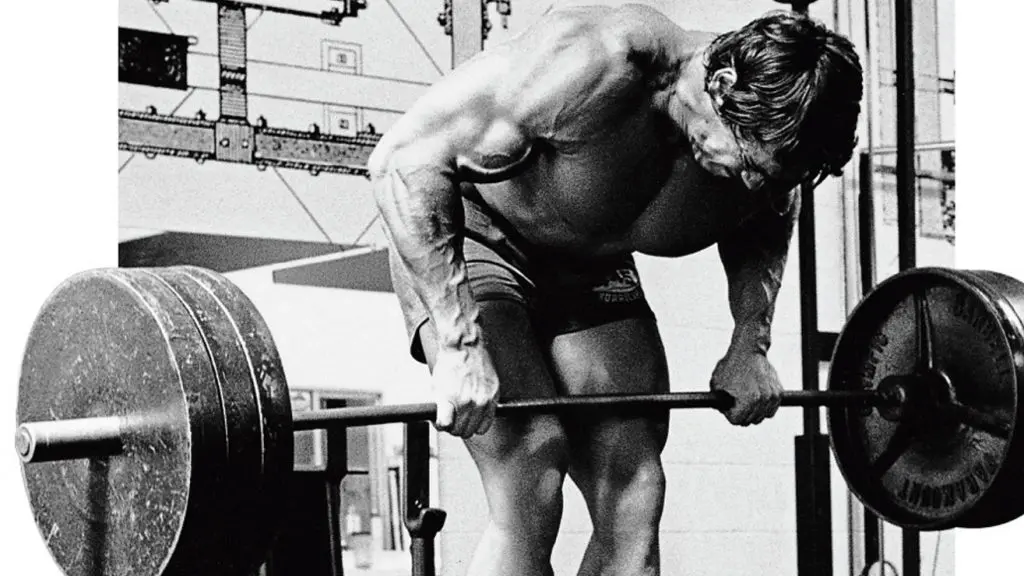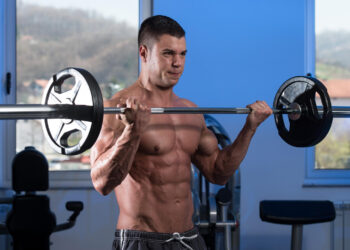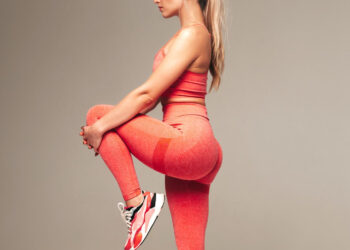When it comes to building maximum size and total strength, nothing compares to the barbell. It’s a legendary tool that was used during the Golden Era and is still a staple for modern training regimes for good reason. You can lift maximal loads (bilateral weight distribution) and there isn’t as much stabilization required to do so.
That’s why the deadlift, squat, bench press, and overhead press are so effective and still recommended to this day. So, we put together the best barbell workout at home that you can do (if you have a barbell, of course) to continue making gains.
It’ll consist of 4 training days and several compound exercises to target every major muscle group twice per week.
Note: You’ll need a barbell and weights for this workout. If you don’t have one, then you can do the workout using dumbbells. But if you don’t have any workout equipment, we have plenty of great articles for you to progress using your own bodyweight.
Read: Best dumbbell workout to build muscle at home.
Best Barbell Workout
Make sure to warm up your joints before doing the workout by taking a few minutes to do some light aerobic activity. This will also increase your heart rate and prepare you for the intense workout routine. Then, do a few progressive warm up sets of each exercise prior to doing your working sets. Start with the bar and do a few reps, then increase the load until you’re training with your main workload/s.
Level Up Your Fitness: Join our 💪 strong community in Fitness Volt Newsletter. Get daily inspiration, expert-backed workouts, nutrition tips, the latest in strength sports, and the support you need to reach your goals. Subscribe for free!
Use a challenging load that will allow you to perform roughly the number of reps recommended below each exercise.
Day 1: Legs and shoulders
Legs
Deadlift or Romanian deadlift
The deadlift and all of its variations is the best total body exercise that you can do. It works everything from the legs to the core, back, and even biceps. However, for this workout, it’s a great option to build the lower body especially when you don’t have a squat rack since you only have to pull it off the floor.

Of course, it’s not as simple as just pulling it off the floor. But, there’s not much setup or balance required compared to squat variations.
The conventional deadlift is performed by pulling the weight off the floor while the Romanian deadlift typically involves lowering the bar down to mid-shin level.
- 3 sets x 10-12 reps (rest 1:30 between sets)
Walking lunges
Lunges are a great functional exercise that promotes balance, stabilization, and unilateral (affecting one side) development. If you want to improve positional awareness and develop equal strength on both legs, the walking lunge is also an awesome movement since you’re not just standing in place.
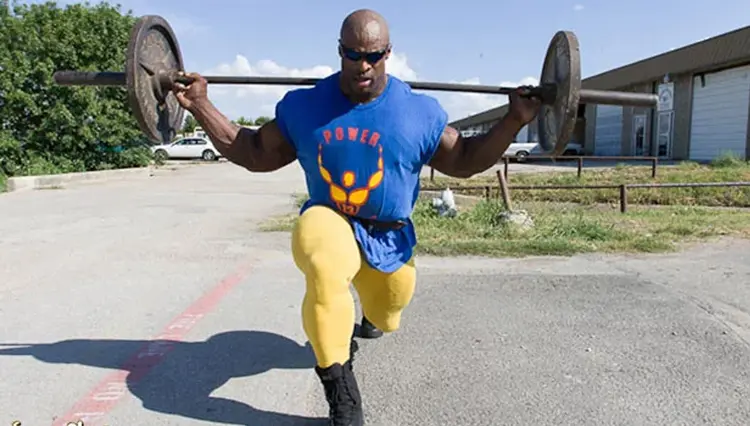
The barbell lunge is definitely more challenging than other variations though since you’re kind of locked in up top. But just start light and continue to progress until you’re able to add weight.
- 2 sets x 15 reps each leg (rest 1:30 between sets)
Hip thrusts
Barbell hip thrusts are a superior glute and hamstring exercise plus you get the benefit of working hip flexor muscles which are crucial for all lower-body movements. You can load up the weight on hip thrusts and really develop an impressive derriere (butt) that turns heads.
- 1 set x 15 reps
Shoulders
Overhead press
The barbell overhead press is quite possibly the best shoulder exercise for developing overall mass and strength.
This movement targets the front and lateral delts of which the latter contributes largely to increased width. It’s also very beneficial for improving shoulder stabilization and stability as well as full body stabilization since the bar is held overhead.
- 3 sets x 10 reps (rest 1 minute between sets)
Barbell high row
You must incorporate movements that work the upper posterior chain which includes the upper back and rear deltoids. This is crucial for preventing anterior and posterior imbalance, plus it’s very good for encouraging and maintaining a healthy posture which is essential for good structural health.
The barbell high row is a great way to utilize a barbell and maximum poundages to put size on those rear delts. When well developed, the rear delts add dimension, and training them sufficiently is non-negotiable.
- For this variation, you want to start in the bent-over position, and then take a wide grip and bend the elbows. You’ll then pull the bar up to the upper chest. This exercise is conducive to using heavy weight which is perfect for building mass.
This exercise becomes optimal the farther you’re able to pull your arms behind your body so keep your elbows bent to do so.
- 3 sets x 10 reps (rest 45 seconds between sets)
Here’s an example…
Day 2: Chest and back
Chest
Floor press
The floor press is very similar to the bench press except you won’t have the same range of motion and stretch in the pecs. And that’s completely fine. In fact, the floor press is an excellent exercise for reducing shoulder strain. Plus, it really improves your triceps and front delts which contribute largely to pressing movements, in addition to the chest muscles.
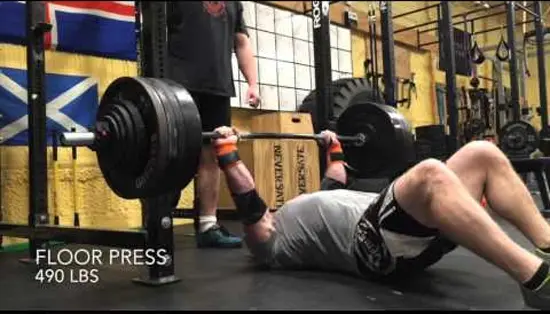
You’ll either need a partner for these or something that you can rack the barbell across as it’d be difficult to get into position otherwise.
- 3 sets x 8-10 reps (rest 1 minute between sets)
Here’s a guide for how to do the floor press correctly.
Level Up Your Fitness: Join our 💪 strong community in Fitness Volt Newsletter. Get daily inspiration, expert-backed workouts, nutrition tips, the latest in strength sports, and the support you need to reach your goals. Subscribe for free!
Landmine incline press
To emphasize more of the upper chest near the clavicle, we recommend the landmine incline press which is truly an amazing exercise. Another great benefit of this movement is that you can get really good arm adduction to elicit a better contraction in the chest. Therefore, it’s a very effective exercise for chest development.
- 3 sets x 12 reps (rest 1 minute between sets)
Read: Landmine press guide for beginners.
Back
Bent-over rows
One study conducted by ACE research found that the bent-over row is a superior exercise compared to several other common back exercises. The reason being is that it allows you to best work your back symmetrically from top to bottom. (1)
That’s right, it works the lats, erector spinae, traps, and rhomboids to a similar degree. The barbell bent-over row is also a great option for lifting heavy which as you know, is necessary for building lots of muscle and a roadmap back.
- 3 sets x 12 reps (rest 1 minute between sets)
Barbell pullover
Because the lats are such a big muscle of the back, it’s always great to include an exercise that places a large emphasis on it. Don’t worry though, it still activates the other back muscles as well.
- Place the barbell on the floor and lie below it. Reach overhead and grip the bar slightly wider than shoulder-width. Bend your arms slightly and pull the bar until it reaches directly above your chest while keeping your lats tight.
The goal here is to focus on a mind/muscle connection to ensure you’re engaging the lats. Your grip will also help to maximally activate the lats.
- 3 sets x 10-12 reps (rest 45 seconds between sets)
Shrugs
Barbell shrugs are a true mass-builder for the trapezius muscles that are located highest on the back. When developed, these muscles give the appearance of power while looking really cool at the same time! Now, most people do these by simply shrugging the shoulders, but you’d be leaving gains on the table by doing the exercise in this manner.
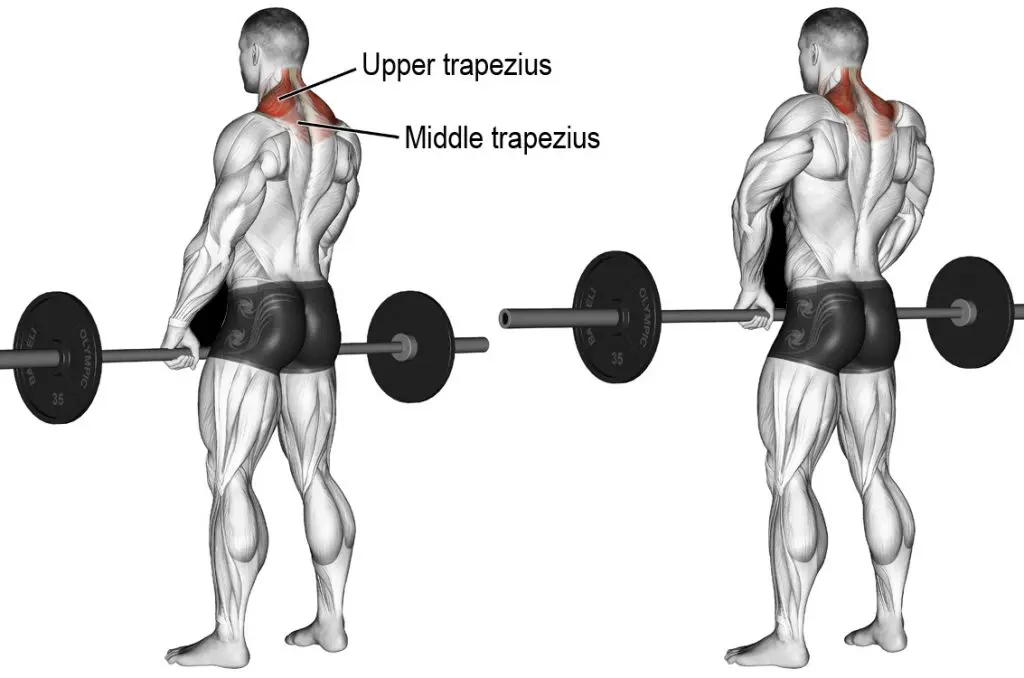
By modifying arm position and leaning slightly forward, we can feel a much better contraction in the muscle. (2)
- Grip the bar slightly wider than shoulder-width and lean slightly forward at the torso. As you shrug, pull your elbows up as well to get an optimal contraction.
Feel free to experiment with the grip and body position until you feel the best possible contraction in the shrugs.
- 2 sets x 15 reps (rest 45 seconds between sets)
Day 3: Rest
Day 4: Legs and shoulders
Same as day 1 workout.
Day 5: Chest, Back, biceps and triceps
Chest
Use the same rest times as above.
Floor press
- 3 sets x 8-10 reps
Landmine incline press
- 2 sets x 12 reps
Back
Bent-over rows
- 3 sets x 12 reps
Barbell pullover
- 2 sets x 10-12 reps
Biceps
Barbell curls into drag curls
Barbell curls allow you to really overload the biceps which in turn, results in more size. And you can always continue to squeeze out reps with biceps training by finishing off with some drag curls. Your biceps will be totally sore the next day but the benefits are well worth it.
To do the drag curl, pull the barbell up the front of your body still using an underhand grip while keeping your elbows back.
- 3 sets x 10-12 reps (rest 1 minute between sets)
Reverse curls
No arm workout is complete without adding in some forearm work in the form of a reverse curl. But more specifically, we’re referring to the brachioradialis which is located on the knuckle side of the forearm. It makes the forearms look very impressive and developed overall.
Use lighter to moderate weights with these to prevent excessive wrist strain.
- 2 sets x 12-15 reps (rest 45 seconds between sets)
Triceps
Close-grip floor press
The close-grip bench press also allows you to load up with pretty heavy weight and it effectively works all three tricep heads. For this variation, you want to keep your hands just at or inside shoulder-width and only bring the bar halfway down to not activate the chest as much.
- 3 sets x 8-10 reps (rest 45 seconds -1 minute between sets)
Lying extensions
The lying extension or a similar variation is a must for maximizing the development of the long head of the tricep (largest tricep head). This exercise is unique in that it allows for a really great stretch in the triceps which also contributes largely to its effectiveness.
Every time you train triceps, incorporate some type of tricep extension. Now, most people won’t have a bench at home to do this exercise. So, you can do it lying on the floor.
- Grip the barbell overhead with your hands about shoulder-width apart then pull it overhead extended above your chest to start. Only bend your forearms to let the bar down to the ground and flex your triceps to move the bar back to the starting position.
We positioned this exercise after the close-grip press because you’ll feel it much better in the triceps after your elbows are warmed up. Don’t go too heavy with this exercise either as it can place a lot of stress on the elbows.
- 3 sets x 10-12 reps (rest 45 seconds – 1 minute between sets)
Day 6: Rest
Day 7: Cardio and/or core
Choose your cardio activity and do at least 30 minutes. You can also include cardio throughout the week depending on your goals. We also recommend you do some core training and we’ve got you covered. Here are 10 barbell exercises for abs that will take your gains to the next level.
Repeat
Frequently Asked Questions
Are barbells more effective than dumbbells for building muscle?
Both are ideal for building muscle and each offers its own advantages. Dumbbells require more stabilization which means you can’t use as much weight although you’ll better develop your stabilizer muscles.
Barbells require less stabilization and allow you to lift more weight overall in comparison. This is also better for improving maximum strength.
Overall, we’d say barbells and dumbbells can build a similar amount of muscle. However, which one you choose to train with more will depend on your goals and structural health. But for the best results, we recommend training with both.
What are the best barbell exercises for building muscle?
That’s an easy one. If you’re going to train with a barbell, take advantage of the fact that it allows you to train with maximal loads. This is very important for building muscles.
A few of the very best barbell exercises include…
- Deadlifts or variations
- Squats
- Press (chest and shoulder press)
- Rows
- Curls
We think you’ll get the best bang for your buck with these exercises.
How many times per week can I do barbell exercises/workouts?
How often you train isn’t as important as the overall training volume and certain lifestyle factors. You have to adopt a training regime that maximizes results and prevents overtraining.
If you feel sluggish and experience decreased performance, then you’ll need to either fix your sleep, nutrition, and hydration or train less.
But you’ll need to know your body to understand the best plan of action for you if you experience a decline in performance and results.
Training too heavy and frequently are not recommended as this can lead to burnout and overtraining.
Is it ideal to do barbell-only training?
You certainly can if you know how to do each exercise properly and don’t overtrain. You ideally want to utilize a mix of lighter, moderate, and heavy training days to benefit while not overdoing it.
We don’t necessarily recommend using one method of training though as there are many functional and developmental benefits to be had by incorporating different techniques and utilizing several different types of training tools.
Wrapping Up
With a simple workout as the one detailed above, you’ll definitely get results. Intensity and consistency are key to making gains and there isn’t anything complex about this routine either. If you don’t have a barbell then there are many other great routines that you can do, or opt for dumbbells instead if that’s all you have.


